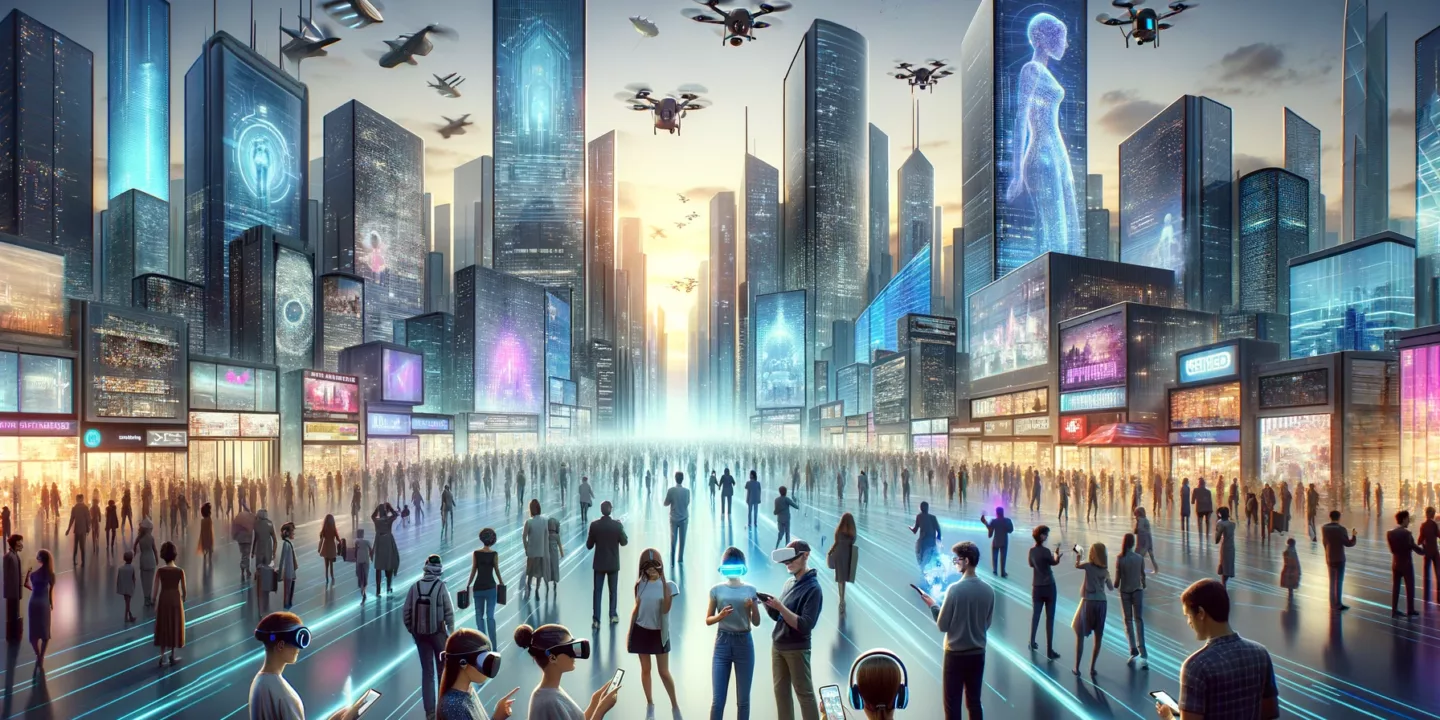
Step into the future and imagine a world where the physical and virtual worlds merge seamlessly. A place where we can interact with digital representations of ourselves and where our wildest dreams become a reality. This is the world of the “Metaverse. As we look beyond 2023, we can expect several trends to shape this technology’s future. Read on as we explore the top 5 metaverse trends impacting how we live, work, and play in the virtual world.
What Is Metaverse and How Does it Work?
The metaverse is a virtual world where users can interact with each other in a simulated environment. It is a 3D space that aims to merge the physical and virtual worlds by providing a platform for people to engage with digital representations of themselves and their environment.
The concept of the metaverse has been around for decades. But, recent technological advancements, particularly in virtual reality (VR) and augmented reality (AR), have brought the idea closer to reality.
The metaverse creates a digital space where users can explore and interact with others. It is an interconnected network of virtual environments accessed through various devices, including VR headsets, smartphones, and computers. Users can create their own avatars and interact with others in a shared virtual space.
As shown in the movie, “Ready Player One,” the metaverse is not limited to gaming and socializing. Many other potential applications exist in areas such as education, healthcare, and business.
For example, virtual training programs can simulate real-world scenarios to improve learning outcomes. Virtual conferences can bring people together worldwide without the need for travel.
Future Trends of Metaverse
1. Gen Z will be the key target audience
Generation Z or Gen Z are individuals born between the mid-1990s and the mid-2010s and grew up surrounded by various technologies. Gen Z is also known to be tech-savvy and open to trying out new things. Thus, it is highly probable that they will be the initial and primary users of the metaverse when it becomes widely accessible.
This assertion is based on the fact that Gen Z individuals have grown up with technology as an integral part of their lives. They are digital natives familiar with using smartphones, social media, video games, and other tech tools. They have also witnessed the evolution of technology and are comfortable adapting to new advancements.
Also, they will likely have the necessary skills, knowledge, and experience to navigate this new world.
2. Metaverse and 5G
One of the vital requirements for the metaverse to function seamlessly is an ultra-dense and low-latency computing network. This network must offer speeds that match the demands of highly sophisticated technology.
According to Vertiv, a US-based data center equipment provider, the rise of 5G technology will fulfill this need.
Vertiv predicts that the intersection of the metaverse and 5G will happen in 2023. They believe that metaverse implementations will leverage 5G networks to enable the ultra-low latency features that the application demands.
With 5G technology, users can expect to experience faster and more reliable connections, essential for real-time interaction and immersive experiences in the metaverse.
3. Corporate Metaverse
According to BCG, the Metaverse is starting to gain momentum in corporate spaces. This is due to the decreasing costs and easy accessibility of AR and VR headsets.
The primary use case of the metaverse is digital twins.
Digital twins simulate the real world linked to IoT devices. It allows businesses to visualize and process complex data sets quickly and efficiently. This visualization enables the representation of the physical world in the virtual realm, providing opportunities for more effective planning, monitoring, and problem-solving.
The second use case, training, involves creating simulations and scenarios for employees to practice in a safe environment.
The metaverse provides a platform for immersive and interactive training. It enables employees to learn and practice skills in a virtual setting. It can reduce the risks and costs of traditional training methods.
4. Regulatory Framework
As the metaverse becomes more prevalent and integral to our lives, there is a need to establish a regulatory framework to address issues related to governance, intellectual property, and data privacy.
Governments and regulatory bodies are starting to recognize the need for such a framework and are taking steps toward developing guidelines and standards. This framework would balance the need for innovation and creativity while protecting users’ rights and safety.
For example, the European Union has initiated the Digital Services Act and Digital Markets Act. It aims to regulate digital services and online platforms, including those operating in the metaverse.
This regulatory framework is expected to evolve over time as the metaverse develops and new challenges and opportunities emerge. The framework aims to provide a safe and secure environment for users to engage with the metaverse while promoting innovation and economic growth.
5. Robust Security
Like Web 2.0, security will be critical for the next iteration of the internet and associated technologies, including the metaverse. Thus, a robust security infrastructure can ensure the smooth functioning of the metaverse and prevent any malicious activities.
Security experts warn that all metaverse enthusiasts should be cautious of potential security risks. Meanwhile, the security community is also taking notice of the metaverse’s development.
This indicates that there will be appropriate security measures to identify and address vulnerabilities in the metaverse promptly.
Conclusion
As we look beyond 2023, the metaverse is set to become an even more prominent and transformative technology, shaping how we interact with the world.
With new innovations emerging rapidly, it can be difficult to predict precisely what the metaverse will look like in the future. However, by examining the top 5 metaverse trends discussed, we can get a glimpse of the exciting possibilities that lie ahead.
Whether through socializing, gaming, learning, or even conducting business, the metaverse will undoubtedly change how we interact with each other.
As we continue to explore and develop this exciting technology, we can look forward to a future that is as limitless as our imagination.
FAQs
1. What are the potential applications of the metaverse?
The potential applications of the metaverse are diverse and wide-ranging.
The metaverse has the potential to be used for gaming, socializing, virtual training and education, healthcare, and therapy, virtual conferences and events, online shopping and retail, and much more.
It can also provide new opportunities for creativity and expression, as users can create and share digital content within the metaverse.
2. What challenges does the metaverse face?
The metaverse faces several challenges, including security and privacy, regulation, and accessibility.
Ensuring the safety and security of users within the metaverse will be crucial for its success. Also, there is a risk that the metaverse could promote inequality if it is not accessible to everyone, regardless of factors such as income or disability.
3. How will advancements in technologies impact the development of the metaverse?
Advancements in technologies such as 5G, artificial intelligence (AI), blockchain, and virtual and augmented reality (VR/AR) will play a crucial role in the development and growth of the metaverse.
For example, the high-speed, low-latency capabilities of 5G networks will enable the ultra-low latency features that the metaverse requires. AI and blockchain can enhance the realism and interactivity of the metaverse. At the same time, VR/AR will provide users with more immersive and realistic experiences.
Overall, these technologies will help to overcome many of the technical and practical challenges that the metaverse faces.





